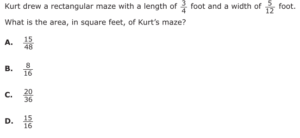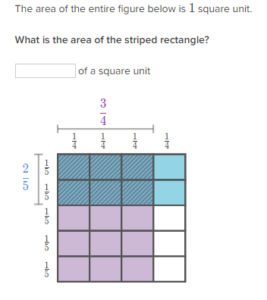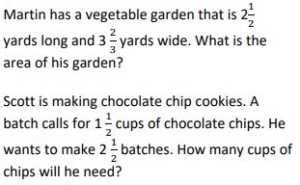Apply and extend previous understandings of multiplication to multiply a fraction or whole number by a fraction.
- Interpret the product (a/b) × q as a parts of a partition of q into b equal parts; equivalently, as the result of a sequence of operations a × q ÷ b. For example, use a visual fraction model to show (2/3) × 4 = 8/3, and create a story context for this equation. Do the same with (2/3) × (4/5) = 8/15. (In general, (a/b) × (c/d) = ac/bd.)
- Find the area of a rectangle with fractional side lengths by tiling it with unit squares of the appropriate unit fraction side lengths, and show that the area is the same as would be found by multiplying the side lengths. Multiply fractional side lengths to find areas of rectangles, and represent fraction products as rectangular areas.
Students are able to…
- Solve area problems using pictures and models and share strategies and reasoning with others.
- Compare the process of solving area problems with previous work involving multiplying fractions.
- Work with other students in a group using grid paper to model problems involving fractional quantities for the dimensions, and discuss how to find the area of the rectangle.
Students are able to…because teachers:
- Provide students with problem contexts where they find the area of a rectangle with one side that is a fraction and the other side a whole number.
- Extend problem solving situations to include finding the area of a rectangle with both sides as lengths in fractions or mixed numbers.
- Ask students to explain their thinking using pictures, words, and numbers.
- Ask students to compare previous work with multiplying fractions to the solutions in these problems and look for similarities and differences, paying close attention to the pictures.
[divider] [/divider]
Questions to ask students:
When you multiply two fractions together, is the product larger or smaller than the factors? Why is that?
Sample answer that indicates understanding: When you multiply fractions you are talking about taking a piece of a piece of a whole. You are making that first piece smaller. This is the same thing that happens when you multiply a whole number by a fraction: You are taking a piece of the whole, so the product will be less than the whole number.
FSA Notes
Cognitive Complexity Level: Level 2: Basic Application of Skills & Concepts
Achievement Level Descriptions:
Level 2: shows the product of a fraction by a whole number using visual fraction models; solves realworld problems involving multiplication of a fraction by a whole number by using visual fraction models or equations to represent the problem
Level 3: finds the product of two fractions by using an area model; generalizes that a/b x c/d = (ac)/(bd) and uses it to solve mathematical or realworld problems involving multiplication of fractions
Level 4: solves real-world problems involving multiplication of fractions and mixed numbers; creates a real-world context involving multiplication of fractions and/or mixed numbers
Level 5: finds the possible fractional dimensions of a rectangle given the area; solves multistep mathematical and real-world problems involving multiplication of whole numbers, fractions, and/or mixed numbers
Assessment Limits:
- Visual models may include:
- Any appropriate fraction model (e.g., circles, tape diagrams, polygons, etc.)
- Rectangle models tiled with unit squares
- For tiling, the dimensions of the tile must be unit fractions with the same denominator as the given rectangular shape.
- Items may not use the terms “simplify” or “lowest terms.”
- Items may require students to interpret the context to determine operations.
- Fractions may be greater than 1.
- For given fractions in items, denominators are limited to 1‐20.
Note MAFS.5.NF.2.4 also assesses MAFS.5.NF.2.6
Context? – Allowable for MAFS.5.NF.2.4. Required for MAFS.5.NF.2.6
[divider] [/divider]
Additional Resources:
Additional in depth content knowledge:
Videos:
Video of a lesson teaching this standard
Khan Academy video reviewing how to multiply fractions using a visual model
Sample Formative Assessment Tasks:
[divider] [/divider]
 [divider] [/divider] Resources to help your child at home:
[divider] [/divider] Resources to help your child at home:
Virtual Manipulative: Interactive Geoboard
Multiplying Two Fractions Video
• Virtual Manipulatives: Rectangle Model of Multiplication of Fractions


